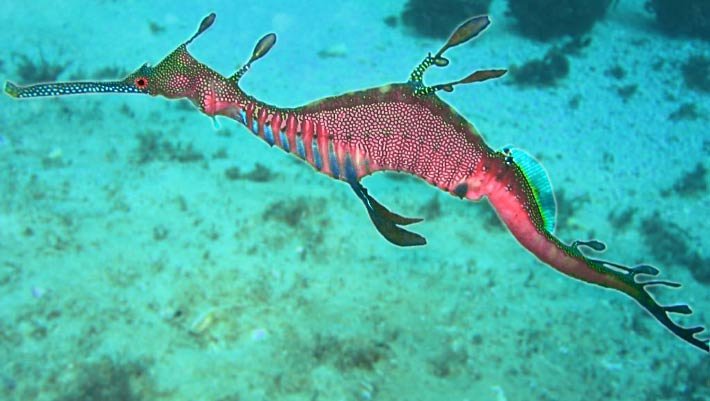How To Train Your Sea Dragon





The name “sea dragon” might bring up images of monstrous, reptilian creatures that can upend fleets and are as wild and untamable as the sea. But it turns out they’re not quite so fierce. Let’s dive into it!
What is it? Sea dragons are most closely related to seahorses and pipefish. So, they’re actually just really weird-looking fish.
Where do they live? In the ocean, obviously! Specifically, in the cool waters of southern Australia. They’re fond of seagrass beds, which makes sense when you look like a plant drifting in the water.
What do they eat? Don’t let their diminutive size and graceful drifting fool you—they’re ravenous hunters. Sea dragons eat small crustaceans and zooplankton, sucking them up through their straw-like mouths. Personally, that’s not for me; seafood grosses me out. Back when I worked at an aquarium, weedy sea dragons were the second most expensive animals to feed, after the sea otters. The mysid shrimp they eat have to be flown in live because sea dragons are notoriously picky eaters.
What does dragon dating look like? I’m so glad you asked. Sea dragons are experts when it comes to romance. Couples perform an intricate ballet of circles, loops, and synchronized “snoot-to-snoot” swimming. When the mood is just right, they perform their version of the horizontal tango. The male presents his tail, the female places her eggs there, and then the male fertilizes them. Unlike seahorses, sea dragons don’t have a pouch, so the eggs are “glued” to the underside of his tail. The best part? Male sea dragons are very secure in their masculinity and proudly sport the “bright pink eggs on the tail” look. He carries these eggs around for 4 to 6 weeks until they hatch and swim off. Below is a picture of an expectant father.
What are sea dragon superpowers? Sea dragons are amazing at being apex predators of small zooplankton. However, their true superpower is camouflage. Each sea dragon has leafy appendages that help them look like floating bits of plants. They also have intricate patterns that allow them to blend in with the seagrass. Each sea dragon’s pattern is like a fingerprint, and researchers can identify individuals by these unique patterns.
How many sea dragons are there? There are three distinct species of sea dragons. The frilliest and most ornate are called leafy sea dragons, Phycodurus eques. Next is the slightly smaller and more petite-leafed weedy sea dragon, Phyllopteryx taeniolatus. Lastly, there’s the newly discovered ruby sea dragon, Phyllopteryx dewysea, which was first described in 2015! It’s incredible that we’re still discovering new species.!
Now for the science stuff (it’s important too).
There are three species of sea dragons.
Leafy sea dragons, Phycodurus eques.
Weedy sea dragons, Phyllopteryx taeniolatus
Ruby sea dragon, Phyllopteryx dewysea
According to the IUCN Red List, two species of seadragons are listed as Least Concern, but their numbers are going down. The Ruby seadragon is data deficient at this point in time. Threats come in the form of over-harvesting, pollution from urban and agricultural runoff, and habitat loss and degradation.
Resources:
New England Aquarium. (ND). Sea dragons. Exhibits. https://www.neaq.org/exhibit/seadragon-exhibit.
Pollom, R. (2017). Phyllopteryx taeniolatus. The IUCN Red List of Threatened Species 2017: e.T17177A67624517. https://dx.doi.org/10.2305/IUCN.UK.2017-2.RLTS.T17177A67624517.en.
Scripps Institute of Oceanography. (ND). Weedy Seadragons. Birch Aquarium. https://aquarium.ucsd.edu/animals/weedy-seadragons#:~:text=Dancing%20Dragons&text=An%20egg%20transfer%20is%20quick,down%20in%20the%20water%20column.

